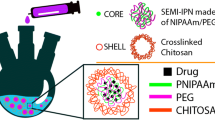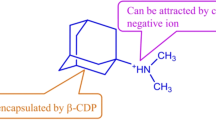ABSTRACT
Purpose
To understand in situ drug thermodynamic activity when embedded in a supramolecular structured hydrophilic matrix that simultaneously self-assembled during drug supersaturation.
Methods
A propylene glycol (PG)/water, hydroxypropyl methyl cellulose matrix containing ethanol was used to support diclofenac supersaturation. Phase behaviour, thermodynamics and drug transport were assessed through the determination of evaporation kinetics, supersaturation kinetics and transmembrane penetration.
Results
Initial ethanol evaporation from the drug loaded matrix (2.9 ± 0.4 mg.min−1.cm−2) was comparable to that of the pure solvent (ca. 3 mg.min−1.cm−2). When 25% w/w of the total ethanol from the applied phase was lost (ethanol/water/PG molar ratio of 7:5:1.2), an inflection point in the evaporation profile and a sudden decrease in drug solubility demonstrated that a defined supramolecular structure was formed. The 55-fold decrease in drug solubility observed over the subsequent 8 h drove in situ supersaturation, the rate of which was a function of the drug load in the matrix (y = 0.0078x, R2 < 0.99).
Conclusion
The self-assembling supramolecular matrix prevented drug re-crystallisation for >24 h, but did not hinder mobility and this allowed the thermodynamic activity of the drug to be directly translated into highly efficient transmembrane penetration.





Similar content being viewed by others
REFERENCES
Davis AF, Hadgraft J. Effect of supersaturation on membrane transport: 1. Hydrocortisone acetate. Int J Pharm. 1991;76(1–2):1–8.
Megrab NA, Williams AC, Barry BW. Oestradiol permeation through human skin and silastic membrane: effects of propylene glycol and supersaturation. J Contr Release. 1995;36(3):277–94.
Schwarb FP, Imanidis G, Smith EW, Haigh JM, Surber C. Effect of concentration and degree of saturation of topical fluocinonide formulations on in vitro membrane transport and in vivo availability on human skin. Pharm Res. 1999;16(6):909–15.
Higuchi T. Physical chemical analysis of percutaneous absorption process from creams and ointments. J Soc Cosmet Chem. 1960;11:85–97.
Iervolino M, Cappello B, Raghavan SL, Hadgraft J. Penetration enhancement of ibuprofen from supersaturated solutions through human skin. Int J Pharm. 2001;212(1):131–41.
Leichtnam ML, Rolland H, Wuthrich P, Guy RH. Impact of antinucleants on transdermal delivery of testosterone from a spray. J Pharm Sci. 2007;96(1):84–92.
Brown MB, and Jones SA. Topical formulations. [WO2007031753]. 2007.
Reed BL., Morgan TM, Finnin BC. Dermal penetration enhancers and drug delivery systems involving same. [6818226]. 2004.
Reid ML, Brown MB, Jones SA. Manipulation of corticosteroid release from a transiently supersaturated topical metered dose aerosol using a residual miscible co-solvent. Pharm Res. 2008;25(11):2573–80.
Reid ML, Jones SA, Brown MB. Transient drug supersaturation kinetics of beclomethasone dipropionate in rapidly drying films. Int J Pharm. 2009;371(1–2):114–9.
Jones SA, Reid ML, Brown MB. Determining degree of saturation after application of transiently supersaturated metered dose aerosols for topical delivery of corticosteroids. J Pharm Sci. 2009;98(2):543–54.
Smyth HDC. The influence of formulation variables on the performance of alternative propellant-driven metered dose inhalers. Adv Drug Deliv Rev. 2003;55(7):807–28.
Van Wesenbeeck I, Driver J, Ross J. Relationship between the evaporation rate andvapor pressure of moderately and highly volatile chemicals. Bull Environ Contam Toxicol. 2008;80(4):315–8.
Vervaet C, Byron PR. Drug-surfactant-propellant interactions in HFA-formulations. Int J Pharm. 1999;186(1):13–30.
Bairamov DE, Chalykh AE, Feldstein MM, Siegel RA. Impact of molecular weight on miscibility and interdiffusion between poly(N-vinyl pyrrolidone) and poly(ethylene glycol). Macromol Chem Phys. 2002;203(18):2674–85.
Walkow JC, Mcginity JW. The effect of physicochemical properties on the in vitro diffusion of drug through synthetic membranes and Pigskin.1. Methyl Salicylate. Int J Pharm. 1987;35(1–2):91–102.
Sasutjarit R, Sirivat A, Vayumhasuwan P. Viscoelastic properties of Carbopol 940 gels and their relationships to piroxicam diffusion coefficients in gel bases. Pharm Res. 2005;22(12):2134–40.
Di Colo G, Carelli V, Giannaccini B. Vehicle effects in percutaneous absorption: In vitro study of influence of solvent power and microscopic viscosity of vehicle on benzocaine release from suspension hydrogels. J Pharm Sci. 1980;69(4):387–91.
Herkenne C, Naik A, Kalia YN, Hadgraft J, Guy RH. Effect of propylene glycol on ibuprofen absorption into human skin in vivo. J Pharm Sci. 2008;97(1):185–97.
Watkinson RM, Guy RH, Hadgraft J, Lane ME. Optimisation of Cosolvent Concentration for Topical Drug Delivery - II: Influence of Propylene Glycol on Ibuprofen Permeation. Skin Pharmacol Physiol. 2009;22(4):225–30.
Benaouda F, Brown MB, Ganguly S, Jones SA, Martin GP. Discriminating the molecular identity and function of discrete supramolecular structures in topical pharmaceutical formulations. Mol Pharm. 2012. doi:10.1021/mp300127f.
Benaouda F. A study of in situ supersaturation for skin delivery. Thesis, (PhD). King’s College London. 2010.
Williams RO, Liu J. Influence of formulation additives on the vapor pressure of hydrofluoroalkane propellants. Int J Pharm. 1998;166(1):99–103.
Wensink EJW. Dynamic properties of water/alcohol mixtures studied by computer simulation. J Chem Phys. 2003;119:7308–18.
Chickos JS, Acree WE. Enthalpies of vaporization of organic and organometallic compounds, 1880–2002. J Phys Chem Ref Data. 2003;32(2):519–878.
Noskov S, Lamoureux G, Roux B. Molecular Dynamics Study of Hydration in Ethanol-Water Mixtures Using a Polarizable Force Field. J Phys Chem B. 2005;109(14):6705–13.
Pecar D, Dolecek V. Volumetric properties of ethanol-water mixtures under high temperatures and pressures. Fluid Phase Equilibr. 2005;230(1–2):36–44.
Li A, Yalkowsky SH. Solubility of Organic Solutes in Ethanol-Water Mixtures. J Pharm Sci. 1994;83(12):1735–40.
Dixit S, Crain J, Poon WCK, Finney JL, Soper AK. Molecular segregation observed in a concentrated alcohol–water solution. Nature. 2002;416:829–32.
Frank HS, Evans MW. Free volume and entropy in condensed systems. III. Entropy in binary liquid mixtures; partial molal entropy in dilute solutions; structure and thermodynamics in aqueous electrolytes. J Chem Phys. 1945;13:507–32.
Franks F, Ives DJG. The structural properties of alcohol-water mixtures. Q Rev. 1966;20:1–45.
Tanaka H, Gubbins K. Structure and thermodynamic properties of water–methanol mixtures. J Chem Phys. 1992;97:2626–34.
Rubino JT, Obeng EK. Influence of solute structure on deviations from the log-linear solubility equation in propylene glycol:water mixtures. J Pharm Sci. 1991;80(5):479–83.
Smith CC, Lof G, Jones R. Measurement and analysis of evaporation from an inactive outdoor swimming pool. Solar Energ. 1994;53(1):3–7.
Leichtnam ML, Rolland H, Wuthrich P, Guy RH. Enhancement of transdermal testosterone delivery by supersaturation. J Pharm Sci. 2006;95(11):2373–9.
Raghavan SL, Trividic A, Davis AF, Hadgraft J. Effect of cellulose polymers on supersaturation and in vitro membrane transport of hydrocortisone acetate. Int J Pharm. 2000;193(2):231–7.
Yalkowsky SH, Valvani SC, Amidon GL. Solubility of nonelectrolytes in polar-solvents.4. Nonpolar drugs in mixed solvents. J Pharm Sci. 1976;65(10):1488–94.
ACKNOWLEDGMENTS AND DISCLOSURES
We gratefully acknowledge the financial support (FB) from the Algerian Ministry of Higher Education and Scientific Research.
Author information
Authors and Affiliations
Corresponding author
Rights and permissions
About this article
Cite this article
Benaouda, F., Brown, M.B., Martin, G.P. et al. Triggered In Situ Drug Supersaturation and Hydrophilic Matrix Self-Assembly. Pharm Res 29, 3434–3442 (2012). https://doi.org/10.1007/s11095-012-0838-x
Received:
Accepted:
Published:
Issue Date:
DOI: https://doi.org/10.1007/s11095-012-0838-x




